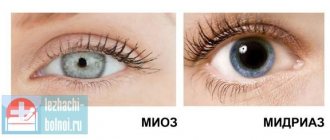The reasons why a person sees black dots and threads in his eyes when looking at a light surface can be varied. Therefore, if worm-like stripes appear constantly and they interfere with normal vision, you need to visit an ophthalmologist and find out the exact diagnosis. If the disease is not advanced, it will be possible to get rid of it in a conservative way. Otherwise, laser correction or surgical treatment will be required.
Causes and symptoms
Wrinkling of the vitreous
This is a dangerous pathology, the main reason for its development is eye injury or a complication after ophthalmic surgical procedures. Due to deformation, the gelatinous body decreases in volume, as a result of which the structures covering it gradually peel off. It is because of these disorders that the victim complains that dots appear before his eyes, and when looking at a dim surface, transparent lines float that look like worms or hairs. In addition, the pathological condition is accompanied by discomfort in the eyes and a general deterioration in visual function.
Destruction with crystalline inclusions
This disorder is often diagnosed in patients suffering from diabetes. Other root causes of the disease:
Symptoms may occur with certain pathologies of blood vessels and heart.
- myopia;
- diseases of the cardiovascular system;
- cranial trauma;
- chronic infectious ophthalmological diseases;
- endocrine and hormonal disruptions;
- increased load on the visual system;
- cervical atherosclerosis.
The patient has shiny silver or golden stripes flashing before his eyes, and white spots may also be visible. This pathology is rarely accompanied by negative symptoms, so it is often diagnosed at advanced stages. Untimely treatment of destruction leads to vitreous detachment and complete loss of vision.
Granular destruction
The disease develops against the background of an inflammatory complication that affects the vascular structures of the visual system. As the pathology progresses, the patient notices that small spots in the form of grains with a brown or gray color appear in the field of vision. The spot itself is formed by pigment cells that migrate to the organs of vision from the affected surrounding tissues.
Grainy brown or gray dots in the eyes can be a symptom of an intraocular tumor or brain cancer, so if the signs are severe, expecting the situation to correct itself is dangerous.
Inflammation of the uveal tract and retina
A similar phenomenon can develop against the background of ankylosing spondylitis.
This disorder is often diagnosed and is often a symptom of the progression of other more severe internal pathologies, such as:
- rheumatism;
- rheumatoid arthritis;
- Bekhterev's disease;
- Reiter's syndrome.
A common cause of uveitis is infection with infectious pathogens, such as:
- toxoplasma;
- chlamydia;
- tuberculosis bacillus.
Inflammation of the uveal tract can be caused by fungi, parasites and viral pathogens - cytomegalovirus, herpes virus and others. As the inflammatory disease progresses, the patient complains that it is as if there are strings floating before the eyes; if uveitis is not treated, the retina is gradually involved in the pathological process. Over time, the patient begins to see worse, pain symptoms may appear or be completely absent.
What to do when flying flies appear?
The best thing to do when flying flies appear is to consult an ophthalmologist. It is advisable to see a fundus specialist - a retinologist. There is a doctor of this specialty in every clinic that deals with laser vision correction, as well as in centers that specialize in diseases of the posterior part of the eye. In addition to examining the fundus, it is advisable to do an ultrasound of the eyes. It is especially important to consult a doctor as soon as possible in case of a spontaneous increase in the number or size of flies and, even more so, when sparks/lightning appear
.
However, you should not panic when flies appear, especially if there are small numbers of them, which cause psychological discomfort rather than real vision problems. There are “floaters” that a person sees in bright light, when looking at snow, at a blue sky, and they are almost constant. Sometimes a person pays attention to them, sometimes not. Do not be surprised that in some cases the doctor will not detect problems with the vitreous humor at all. The size, structure and composition, as well as the location of the floaters, are all important in identifying the cause of the phenomena that bother patients.
Diagnostic methods
The organs of vision can be examined in detail using a slit lamp.
If light or dark threads constantly flash before your eyes, and you are also bothered by the feeling of the presence of a foreign body, which prevents you from viewing the object normally, you need to make an appointment with an ophthalmologist. After a series of diagnostic measures, the doctor will advise how to get rid of this pathology. Worms, threads and ribbons in the field of view are often a symptom of an ophthalmological disorder, to identify which the following diagnostic procedures are prescribed:
- ophthalmoscopy;
- biomicroscopy;
- optical coherence tomography;
- visometry;
- tonometry;
- examination of the eyeball using a slit lamp;
- Ultrasound, CT or MRI of the visual system.
If concomitant diseases were identified during the research, additional consultation with the following doctors will be required:
- neurologist;
- cardiologist;
- endocrinologist;
- infectious disease specialist;
- oncologist.
Why are myopic eyes oval shaped? Delivery of contact lenses and glasses in Moscow and Russia
The diameter of the eye in a person with myopia exceeds the norm by 23-24 mm and can be 30 mm or more.
The eyeball increases in length, as a result of which light rays, after refraction, end up not at the central point of the retina, but in front of it. One of the reasons for rapid eye growth is weakness of the sclera. Let's find out how this process happens. Myopia, or myopia, is a refractive error accompanied by decreased distance vision. Distant objects appear blurry. The ability to see well up close is preserved.
This happens due to improper refraction of rays. They are collected not on the retina, but in the plane in front of it. When a person looks ahead, he does not notice any symptoms of visual impairment.
But as soon as you look into the distance, the picture blurs.
When reading or working at a computer, the eye's accommodation mechanism is activated. It works like this:
- the ciliary muscle, which regulates the curvature of the lens, contracts;
- the ligament of Zinn relaxes;
- the shape of the transparent body and its refractive power changes;
- the pupil narrows.
This increases the load on the choroid, sclera and other structures of the eye. When a person turns his gaze to distant objects, the reverse process occurs. The ligament of Zinn tenses and the ciliary muscle relaxes. The lens changes its shape again, and its refractive power decreases.
Due to increased visual stress, lack of visual hygiene, hereditary predisposition to myopia, and lack of certain vitamins and minerals, myopia develops in the body. There are 3 main reasons:
- increase in the linear dimensions of the eyes;
- impaired refraction of light in the lens and cornea;
- decreased accommodation capabilities.
Increased eye size due to myopia
Rapid and abnormal eye growth in myopia occurs due to weakness of the sclera, or outer membrane. It should be very dense, since its main function is to maintain the shape of the eyeball. Visual load is combined with a phenomenon called convergence, in which the visual axes are brought together.
This is necessary for viewing objects close to a person. Pressure is exerted on the walls and membranes of the eye. It temporarily takes on an oval, ellipsoidal shape. In other words, the eyeball is extended in the anteroposterior direction. As soon as you look into the distance, it becomes spherical again.
This is ensured by the density of the sclera.
If the scleral membrane is weak, then with prolonged visual stress it stretches too much, but after that it does not return to its original state. This is a residual deformation of the sclera. Its presence indicates the development of myopia.
There may be another reason for the increase in eyeball length. It is related to intraocular pressure. Leaning your head forward, for example when reading, causes a slight increase in pressure in the eyes.
If the outer shell is weak, it stretches. But in this case, there is growth of the eyeballs along the entire perimeter. They become round instead of oval.
At the same time, myopia continues to develop, and vision continues to decline.
Causes of changes in eye shape and scleral weakness
So, myopia arises and progresses due to the growth of the eyeballs, which occurs due to the weakness of the sclera.
What is the cause of this defect? What factors affect the condition of the sclera? Often we are talking about genetic predisposition. Myopia is passed on from parents to children.
The mechanism of transmission of the defective gene has been studied, but to date no methods have been developed to influence it.
There are other factors that cause scleral weakness. In order for it to remain dense, the body should not lack calcium, copper and zinc. Poor nutrition can cause myopia.
Modern diagnostic methods make it possible to identify residual deformation of the outer shell. This is done using ultrasound examination of the anteroposterior axis of the eyeball.
It is also possible to suspect scleral weakness in a child. In children with this feature of the outer membrane, insufficient collagen synthesis is observed. It is an important component of ligaments and skin.
Thin skin and excessive joint mobility may indicate a lack of collagen.
Pathological changes in the eyes due to myopia
Eye growth leads to progression of refractive error. At the same time, serious changes also occur inside the eyeballs.
Some of them are very dangerous and can lead to severe vision loss and even blindness. Pathological processes in the fundus can be examined using ophthalmoscopy.
This research method allows you to identify changes in the central region of the internal structures of the eye and in the periphery of the fundus.
The macula is located in the center of the fundus of the eye. With a high degree of myopia, maculopathy develops with varnish cracks and hemorrhages. These pathological processes sometimes lead to choroidal neovascularization, or proliferation of blood vessels, which inevitably causes severe visual impairment.
Stretching of the sclera can lead to the formation of myopic cones located near the optic nerve head. The progression of myopia often provokes its atrophy or dystrophy of the choroid with its subsequent thinning.
Ophthalmoscopy can also show changes in the periphery of the fundus. Degenerative processes affecting the retina and vitreous body are observed. Floating spots appear in the field of vision. The risk of retinal detachment increases. With high myopia, this can occur as a result of injury, inflammatory disease or heavy physical activity.
People with myopia need to visit an ophthalmologist more often. The treatment of this refractive error should be approached comprehensively; it should be prevented, especially in childhood, in order to prevent serious consequences that cannot always be corrected later.
Source: https://www.ochkov.net/informaciya/stati/pochemu-pri-blizorukosti-glaza-ovalnoj-formy.htm
What treatment is prescribed?
Medication
With the help of a set of medications, the patient can get rid of the disturbing symptom.
If black threads in front of the left or right eye arose as a result of the progression of destruction of the vitreous body, then at unadvanced stages the patient will successfully get rid of the pathology in a conservative way. The white, shiny or black stripe will disappear if you use the following groups of drugs:
- dissolving blood clots;
- normalizing blood circulation in the brain;
- strengthening the organs of vision;
- antioxidants;
- angioprotectors;
- microcirculation correctors.
Surgical
If destructive processes in the vitreous body cannot be corrected conservatively, the doctor decides to perform an operation that will help restore vision, and the white spot, thread or strip will also disappear. Effective surgical procedures are:
Cloudy areas of the vitreous that provoke such symptoms are eliminated using a laser.
- Vitrectomy. During the operation, the surgeon completely or partially removes the affected gelatinous transparent substance, and in its place introduces a silicone, saline or gas implant. The procedure is complex, but after it vision is completely restored.
- Vitreolysis. This is a laser treatment, during which cloudy areas on the vitreous body are split by a laser beam.
After vitrectomy and vitreolysis, rehabilitation recovery is required, during which the patient needs to regularly visit an ophthalmologist, take prescribed medications, and strictly follow the treatment regimen, advice and recommendations. Such rehabilitation measures will help prevent the development of postoperative complications, the risk of which always exists.
Folk remedies
To eliminate spots and spots on the eyes, adherents of unconventional methods recommend using natural medicines prepared at home. But before starting such treatment, you should consult your doctor, and if he doesn’t mind, you can use these simple but effective means:
Yarrow can be used to improve vision.
- water infusion of propolis;
- drops of silver water with honey and aloe juice;
- compresses made from a decoction of chamomile and yarrow.
What it is?
Frightening “worms” before the eyes are most often the result of damage to the vitreous body. When collagen fibers thicken inside the vitreous. If the pathological process involves single fibers, threads, stripes, and cobwebs appear before the eyes. If dead collagen fibers stick together, the result may be visual impairment in the form of jellyfish, octopuses, rations, etc.;
With granular destruction, when compactions in the vitreous are caused by the penetration of hyalocyte cells into it and have clear outlines and a dense structure, the defects appear as black dots before the eyes, circles or rings; During detachment, such “special effects” are often described by patients as flashes of lightning. Such seals cast a shadow on the retina and, as a result, we see similar defects before our eyes. Moreover, the closer these seals are to the retina, the clearer our flies, worms, etc.
The main difference between opacities caused by changes in the vitreous body and others is their “floating” nature. Such floaters in front of the eyes shift when the eyes move in the opposite direction and then little by little “creep” back. Such black dots are especially visible in the eyes against a light background (blue, white), and in most cases they do not cause significant discomfort.
Prevention
If an adult has a distinct dark or light stripe in front of their eyes, which interferes with vision and constantly makes itself felt, it is necessary to make an appointment with an ophthalmologist and undergo a full diagnostic study, which will help establish an accurate diagnosis and find out the causes of the development of the disorder. As a preventative measure, it is recommended to promptly treat infectious and inflammatory diseases, monitor the health of the visual organs, and protect them from ultraviolet radiation, dust, wind and injury. Proper nutrition, a healthy lifestyle, normalization of work and rest, and proper sleep will help strengthen the visual system. In case of severe symptoms and persistent deterioration of vision, self-medication is contraindicated, otherwise complications and dangerous consequences cannot be avoided.









